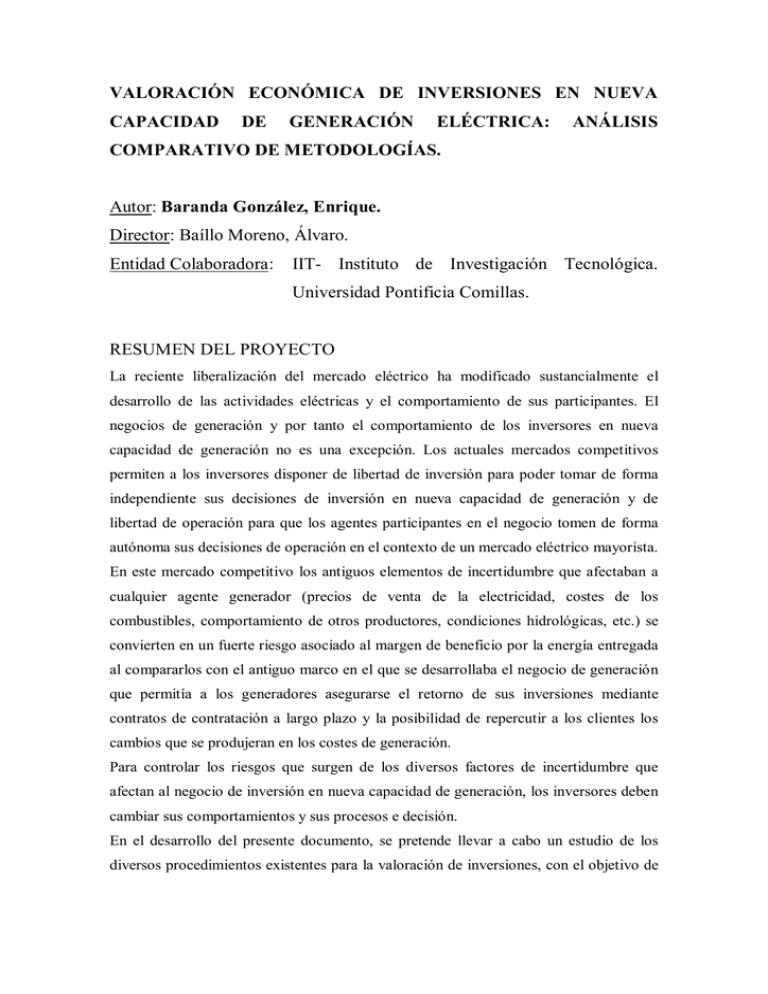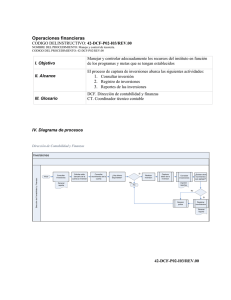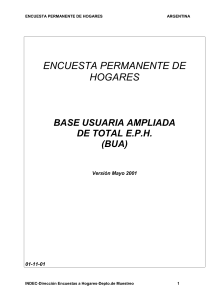VALORACIÌN ECONÌMICA DE INVERSIONES EN NUEVA
Anuncio

VALORACIÓN ECONÓMICA DE INVERSIONES EN NUEVA CAPACIDAD DE GENERACIÓN ELÉCTRICA: ANÁLISIS COMPARATIVO DE METODOLOGÍAS. Autor: Baranda González, Enrique. Director: Baíllo Moreno, Álvaro. Entidad Colaboradora: IIT- Instituto de Investigación Tecnológica. Universidad Pontificia Comillas. RESUMEN DEL PROYECTO La reciente liberalización del mercado eléctrico ha modificado sustancialmente el desarrollo de las actividades eléctricas y el comportamiento de sus participantes. El negocios de generación y por tanto el comportamiento de los inversores en nueva capacidad de generación no es una excepción. Los actuales mercados competitivos permiten a los inversores disponer de libertad de inversión para poder tomar de forma independiente sus decisiones de inversión en nueva capacidad de generación y de libertad de operación para que los agentes participantes en el negocio tomen de forma autónoma sus decisiones de operación en el contexto de un mercado eléctrico mayorista. En este mercado competitivo los antiguos elementos de incertidumbre que afectaban a cualquier agente generador (precios de venta de la electricidad, costes de los combustibles, comportamiento de otros productores, condiciones hidrológicas, etc.) se convierten en un fuerte riesgo asociado al margen de beneficio por la energía entregada al compararlos con el antiguo marco en el que se desarrollaba el negocio de generación que permitía a los generadores asegurarse el retorno de sus inversiones mediante contratos de contratación a largo plazo y la posibilidad de repercutir a los clientes los cambios que se produjeran en los costes de generación. Para controlar los riesgos que surgen de los diversos factores de incertidumbre que afectan al negocio de inversión en nueva capacidad de generación, los inversores deben cambiar sus comportamientos y sus procesos e decisión. En el desarrollo del presente documento, se pretende llevar a cabo un estudio de los diversos procedimientos existentes para la valoración de inversiones, con el objetivo de evaluar las ventajas y desventajas que presentan las inversiones sujetas a incertidumbre para los inversores. El trabajo se organiza de la siguiente manera: El capítulo 1 presenta una introducción , motivación por la que surge el proyecto y una panorámica general de los contenidos. La descripción del marco en el que se desarrollan las inversiones en nueva capacidad de generación se realiza en el capítulo 2. El capítulo 3 revisa la teoría clásica de la inversión , DCF, NPV, CAPM, etc. A continuación, en el capítulo 4 se presentan los fundamentos de la Teoría de las Opciones Reales y su aplicación en las decisiones de inversión. El capítulo 5 compara, mediante el desarrollo de casos reales del sector eléctrico, las diferentes metodologías de valoración de inversiones para, finalmente en el capítulo 6, presentar una serie de conclusiones y posibles futuros desarrollos del trabajo. A continuación se resumen las brevemente las ideas que se han desarrollado a lo largo del proyecto. El métodos más usados por los inversores a la hora de evaluar sus posibilidades de inversión es el DCF1 descontado mediante el criterio del NPV2, que no es más que estimar el futuro flujo de caja que se produzca durante la vida útil de un proyecto t descontarlo mediante el WACC3. Este NPV puede ser calculado bajo escenarios sujetos o no a un determinado grado de incertidumbre. En este último caso, el futuro flujo de caja seguirá una determinada distribución de probabilidad y se usará el NPV esperado para la toma de decisiones por lo que el método presenta el inconveniente de la subjetiva valoración de la distribución de probabilidad que pueda seguir el flujo de caja. Otros procedimientos, cómo los Árboles de Decisión, Análisis de Sensibilidad o Análisis de Escenarios se utilizan también a la hora de valorar oportunidades de inversión bajo escenarios sujetos a ciertos grados de incertidumbre. Una de las limitaciones del DCF es que, incluso utilizando la tasa de descuento propuesta por algunos de los modelos de valoración más avanzados, cómo es el CAPM.4, es incapaz de reflejar las consecuencias que se derivan de una estructura cambiante del riesgo asociado a un proyecto. Por otro lado, el método del DCF asume 1 Discounted Cash Flow (Descuento del flujo de caja) 2 Net Present Value (Valor presente neto). 3 Weighted Average Cost of Capital ( Coste promedio ponderado de capital) 4 Capital Asset Pricing Model. que la posibilidad de inversión no es reversible, es decir que debe ser efectuada ahora o nunca, ignorando el valor que puede aportar a cualquier oportunidad de inversión el valor de la flexibilidad. En los últimos años ha emergido con fuerza, basándose en la Teoría de Opciones Financieras desarrollada por Black y Scholes en 1973, la Teoría de las Opciones Reales para la valoración de las inversiones teniendo en cuenta el valor extra que aporta la flexibilidad. FINANCE VALUATION OF INVESTMENT IN NEW CAPACITY OF ELECTRIC GENERATION. COMPARATIVE ANALYSIS OF METHODOLOGIES. Deregulation has become a focus in electricity industry all over the world. The competitive markets allow new investors to enter. Electricity prices are oriented toward the market and show more fluctuations. All these changes increase the uncertainties in the market and for the producers as well. Many uncertainty factors may influence electricity production and become important risk factors for the investor. They are electricity selling price, load fluctuations, plant availability, fuel cost, hydrological conditions, behaviours of the other producers and so on. Since the consumers can convert to other suppliers, there are uncertainties in supply quantities as well. In addition, comparing to the environment in which returns on investment were assured through long-term power purchasing agreement and the changes in production cost have been passed to the customers, competition increases substantially the financial uncertainties for the producers. The investment costs are affected by uncertainties in interest rate, foreign exchange rate, delay in construction, etc. For managing the risks resulted from the uncertainties, the investors may change their behaviours and their investment decision process. Actually, the investors have more opportunities if they can manage the uncertainties. New values can be created from a flexible investment decision and management with more information along with the time. In this paper, we try to look at different methods available to determinate a finance valuation of investment in new capacity of electric generation in order to take the advantages and avoiding the disadvantages of uncertainties. The paper is organised as follows. An introduction and overview in Section 1, a brief description of the framework of the electricity business is made in Section 2, a review of traditionally valuation method of investment, such as DCF, NPV, CAPM, etc., is carried out in Section 3. The Real Options theory and its application in investment decision is made in Section 4. This is followed in Section 5 by different cases study and the results. Finally, we give a summary of our findings in Section 6. Below a resume of the ideas of the paper is presented. The most widely used method in investment decision is Discounted Cash Flow (DCF) with criterion of Net Present Value (NPV). It is to determine the cash flows over the life of a project and to discount them by the Weighted Average Cost of Capital (WACC). NPV is the difference between the present value of the discounted cash flows and the investment cost. If the NPV is positive, the project is accepted, otherwise, it is rejected. The objective is to maximise the NPV. NPV can be calculated under certainty or under uncertainty. In the latter case, the future cash flows follow a probabilistic distribution and the expected NPV is used to make decision. A Decision Tree can be used to layout future decisions and sources of uncertainties. DCF method relies on subjective assessments of probabilities of future cash flows and subjective risk-adjusted discount rate. In the practice, the fundamental concept of flexibility has been accepted by the decision-makers. Some methods treating the uncertainties such as sensitivity analysis and scenario analysis are frequently used as supplement to DCF. DCF method assumes that the investment opportunity is not reversible and is a now or never opportunity. Since it ignores the ability of management to exploit new information and opportunities, this kind of method often suggests that uncertainty is a negative factor. Another limitation of the DCF method is that it uses the single discount rate of Capital Asset Pricing Model (CAPM). This discount rate cannot reflect a changing risk structure. It is challenged by the risk decrease due to flexibility. Therefore, DCF often underestimates the value of investment strategies. In recent years, increasing attention has been paid on the Real Options theory. After the option pricing breakthrough by Black and Scholes in 1973, the Real Options theory has been derived from the theory of financial options for valuing investment in real (as opposite to financial) assets. It allows evaluating the investment taking into account the value of flexibility embedded in a project. In the changing electricity sector Real Options theory is becoming a valuable tool. There have already been applications in strategic investment planning stage and operating stage. Typical examples are valuation of the option to install duel fuel capacity or the valuation of generation assets.

